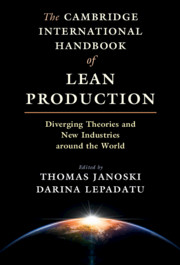 The Cambridge International Handbook of Lean Production
The Cambridge International Handbook of Lean Production Global Diffusion, Societal Effects, Contradictory Implementation
from Part I - Theories of Lean Production
Published online by Cambridge University Press: 11 March 2021
In 1930 the founder of Toyoda Automatic Loom Works, Toyoda Sakichi, instructed his eldest son, Toyoda Kiichirō, to research the auto industry with a view to entering it. In 1933, Kiichirō announced that the company would begin making cars, stating: “We shall learn production techniques from the American method of mass production. But we will not copy it as is. We shall use our own research and creativity to develop a production method based on our own country’s situation” (quoted in Ohno 1988: 91). That situation included a small market that could not justify huge volumes with dedicated machinery, coupled with severe resource constraints. Their goal was to develop a production system based on lower volumes with low inventories. Toyota didn’t implement its first compete just-in-time system until 1958 and was not able to fully debug its kanban (continuous flow) system until 1962, after which it was adopted companywide (Tolliday 1998).
To save this book to your Kindle, first ensure no-reply@cambridge.org is added to your Approved Personal Document E-mail List under your Personal Document Settings on the Manage Your Content and Devices page of your Amazon account. Then enter the ‘name’ part of your Kindle email address below. Find out more about saving to your Kindle.
Note you can select to save to either the @free.kindle.com or @kindle.com variations. ‘@free.kindle.com’ emails are free but can only be saved to your device when it is connected to wi-fi. ‘@kindle.com’ emails can be delivered even when you are not connected to wi-fi, but note that service fees apply.
Find out more about the Kindle Personal Document Service.
To save content items to your account, please confirm that you agree to abide by our usage policies. If this is the first time you use this feature, you will be asked to authorise Cambridge Core to connect with your account. Find out more about saving content to Dropbox.
To save content items to your account, please confirm that you agree to abide by our usage policies. If this is the first time you use this feature, you will be asked to authorise Cambridge Core to connect with your account. Find out more about saving content to Google Drive.